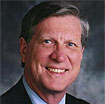If The Homiletical Plot assumes a narrative competence that may no longer be fully in place, my fear about the new didactic approach that we see in Adam Hamilton and others is that it may end up reinforcing the worst tendencies of an episodic culture,
encouraging people to grasp disconnected principles and rules and insights, provided by an authority figure from the outside, in order to survive in the chaotic whirlwind of life.
If we remind ourselves of our main task as preachers, we are not called to evoke a narrative competence already in place in people, nor are we called to provide wise insights for coping with the stresses of life. We are called to proclaim a narrative that people could not conjure up out of their own resources, the gospel narrative, and then to help people let that narrative become the story that shapes, guides, and clarifies their lives and gives them their primary identity.
If people are going to live into the gospel narrative, then they will need the ability to sustain narrative attention, the very thing that Lowry so provocatively heralded in The Homiletical Plot. But in our cultural context, the ability to do this must now be seen as a goal, not an assumed capability. Likewise, as the preaching of Adam Hamilton implies, we may well be in a moment when we need strong and confident teachers of wisdom, but we should not forget that biblical wisdom does not float free from the story of God and God’s people but always rests on a narrative substrate. Lose sight of the narrative, and even biblical wisdom forfeits its edge and becomes a banal form of the power of positive thinking.
The next generation of preaching, then, is going to have to be rhetorically nimble. As Battersby says, “There are, then, many truths we can tell, in long and short forms, about selves, and many ways of telling them, but there is no way to get at the whole truth in any way of telling.”1 Because we are proclaimers of God’s story, we will always be storytellers. But now, in order to tell this story, we must also stand back from it and become teachers and sages and ethical guides. No single homiletical formula will do; no one way of structuring sermons, however compelling, will accomplish the task; no solitary rhetorical strategy will open all the doors of the faithful imaginations of our hearers. We must help people in a fragmented and episodic culture to repair their ability not only to hear the gospel story but also to know what a powerful story is in the first place, how it works, and what possibilities it affords for identity and ethical living. We must use every gift of language, every responsible strategy of communication, to help people see, in practical and concrete ways, the shape of life that results when one builds a nest in the wide and embracing branches of the gospel story.
1Battersby, “Narrativity, Self, and Self-Presentation,” 43.
Excerpted with permission from: What’s the Shape of Narrative Preaching? (Copyright) 2008 Chalice Press.
Order What’s the Shape of Narrative Preaching? at 25% off from the Luther Seminary Bookstore.

